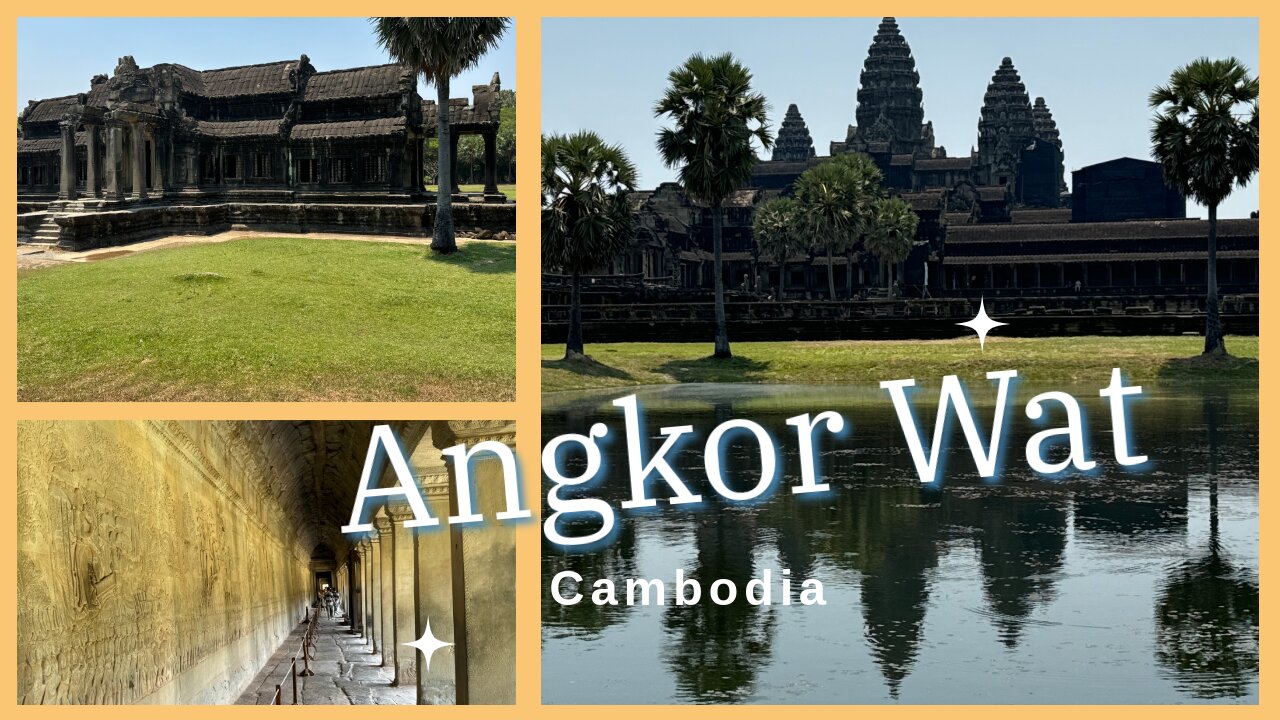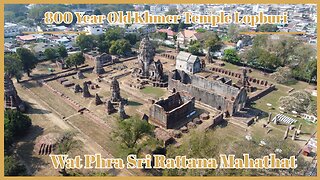Premium Only Content

Angkor Wat អង្គរវត្ត - UNESCO World Heritage Site - Manmade Wonder Of The World - Cambodia 2024
Angkor Wat អង្គរវត្ត
"City/Capital of Temples" is a temple complex in Cambodia and is the largest religious monument in the world, 402 acres.
Originally constructed as a Hindu temple dedicated to the god Vishnu for the Khmer Empire by King Suryavarman II, it was gradually transformed into a Buddhist temple towards the end of the 12th century; as such, it is also described as a "Hindu-Buddhist" temple.
Representing the abode of Hinduism's ancient gods, the spectacular temple of Angkor Wat is quite literally heaven on earth and the jewel in the Khmer archaeological crown. It's the largest of all Angkor's temples and one of the best preserved. Surrounded by a huge rectangular reservoir and an outer wall measuring over 3km in length, the temple consists of three tiered galleries and five towers shaped like lotus buds.
Such is the national pride in the site that the outline of the temple features on Cambodia's national flag. Little can prepare you for the sheer scale, splendor and symmetry of Angkor Wat, a perfect blend of artistic genius and spiritual devotion. Although somewhat neglected after the 16th century, Angkor Wat is unique in that it was never completely abandoned and the moat safeguarded the temple against the encroaching jungle.
Angkor Wat Is one of the ten wonders of the man made world and should be on the list of everyone.
The highpoint of Angkorian architecture and the culmination of centuries of innovation in style, technique and design. Angkor Wat needs no introduction but even at smaller sites such as Prasat Banteay Samre, Prasat Phanom Rung, and Prasat Beng Mealea, all the characteristic elements are on display including; concentric enclosures, raised causeways, cruciform terraces, elaborate gopuras, enclosing galleries, 'libraries', the distinctive 'pineapple' sandstone towers, tiered pediments and lintels featuring finely carved narrative and heraldic designs plus, of course, the iconic devata images.
Aside from the sheer size of Angkor Wat, there are few architectural innovations but what it does see is the successful coming together on a huge scale of centuries of trial, error and experimentation.
In decorative terms, the elaborate, layered pediments, proliferation of iconic devata figures and covering of wall and column spaces with extensive tapestry reliefs was groundbreaking while the extraordinary gallery reliefs of Angkor Wat itself are incomparable in Khmer architecture. (The relief-lined outer galleries total nearly 1km and nearly 2,000 devata figures have been counted.)
Construction methods also seem to have reached a peak during this era with the huge site avoiding the catastrophic collapse of Baphuon and the hasty, poor building work of many subsequent Jayavarman VII sites. A surprising fact considering the sheer number of sites dating to this period although it's clear that many of these sites would have been initiated and completed before and after the reign of Suryavarman II himself.
Enjoy rhe video!
If you would like to support the channel through unique items only found here visit my store
https://youtube.com/channel/UC7Nk0oxkpoyOXvZ-BESD6-g/store
You can also see my videos on Rumble, Bitchute, Odysee and Subscribe Star. If you have any questions or comments and wish to contact me directly I can be reached by email at endlessjourneytravels@gmail.com
https://www.bitchute.com/channel/pYUe8EgYcUMc/
https://odysee.com/$/latest/@EndlessJourney
https://rumble.com/c/EndlessJourney
https://www.subscribestar.com/endless-journey
Follow me on Twitter @AEndlessJourney
#endlessjourney
#travel
#cambodia
-
 15:42
15:42
Endless Journey
14 days ago13th Century Khmer Temple - Wat Phra Sri Rattana Mahathat With Drone Footage - Lopburi Thailand 2025
141 -
 LIVE
LIVE
TimcastIRL
57 minutes agoDemocrat TANTRUM At Trump Speech BACKFIRES, Trump Polls UP, Dems UNDER FIRE w/67Kevin | Timcast IRL
17,858 watching -
 LIVE
LIVE
Kim Iversen
3 hours agoFrom Doctor to Political Prisoner: Dr. Simone Gold on COVID Lies, January 6th, and Medical Tyranny
1,356 watching -
 LIVE
LIVE
The Jimmy Dore Show
2 hours agoZelensky Gets His Head Right & Comes Crawling Back! Americans APPROVE Of Trump Speech! w/Matt Taibbi
20,654 watching -
 LIVE
LIVE
Melonie Mac
4 hours agoGo Boom Live Ep 39!
274 watching -
 45:56
45:56
Glenn Greenwald
3 hours agoLee Fang Reacts to Trump's Speech to Congress; Will DOGE Tackle Military Waste? | SYSTEM UPDATE #418
21K35 -
 43:23
43:23
Donald Trump Jr.
3 hours agoNo Clap: Dems are a Disgrace but My Father is Bringing Back Common Sense | Triggered Ep.222
65.5K80 -
 LIVE
LIVE
Akademiks
4 hours agoDay 1/30. Drake Drops lawsuit vs iHeartMedia? Offset and Cardi Calls it Quits. 50 v Jim Jones?
3,097 watching -
 8:56:13
8:56:13
Dr Disrespect
10 hours ago🔴LIVE - DR DISRESPECT - WARZONE - 150 PLAYER LOBBIES
139K18 -
 1:27:35
1:27:35
Redacted News
4 hours ago"This is NOT normal" Trump just destroyed the woke mob as Dems in disarray | Redacted News Live
114K232